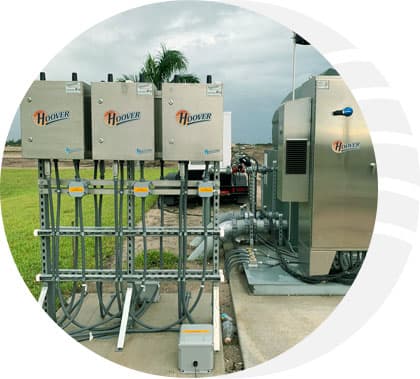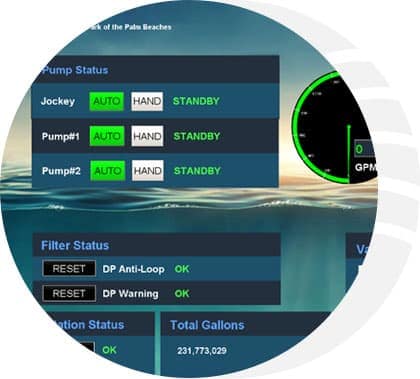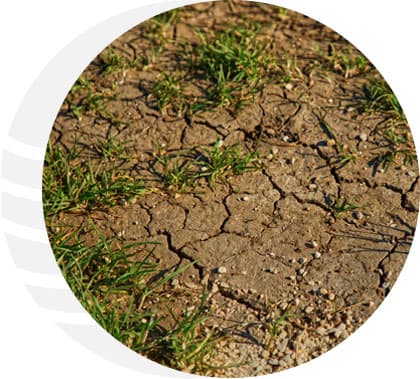Florida’s climate is challenging for landscape management. Long hot and dry spells with occasional very heavy rainfall is not ideal for maintaining the green, tropical landscapes that residents or clients expect to see.


Hoover has been a forward-thinking industry leader producing Florida’s most reliable irrigation solutions since the late 1970s. We’ve been working with those responsible for managing irrigation for commercial and domestic landscapes for decades; providing systems and services that adapt to the unpredictable weather and far exceed Florida’s water conservation legislation. Water delivery systems and irrigation solutions are what we're all about, from pump stations and irrigation pumps to smart irrigation systems.

Hoover opposes the “break and fix’ service business model that provides little to no attention to routine maintenance. Over time we have observed customers becoming acclimated to expect recurring repair expenses as a way of life but the sole beneficiary of this practice is the service provider. It is a fact that maintained equipment performs more reliably and less often experiences a major failure. Hoover’s approach to irrigation pump station design and manufacture provides quality products which provide a long and reliable service life when coupled with proactive management and regular preventative irrigation maintenance. A Hoover solution accompanied with regular Hoover maintenance assures that you will always have dependable access to irrigation water.

If you want to get your irrigation repairs under control, talk to us. We’re helping businesses all over Florida get the right irrigation solutions in place to maintain greener, healthier landscapes and reduce the need for irrigation repairs. If you already own a Hoover pump station, we are here to support you and your irrigation for the long term. Irrigation problems of any kind (for example, volume, pressure, clogging, field breaks and so on) can tie up budgets with unnecessary spending on repairs. We can help improve your irrigation efficiency with irrigation pump station repair and renovation projects and where suitable, provide a pump station replacement. Our team will recommend the best approach to keep your irrigation pump system and the irrigation system functioning reliably for as long as possible.

Here in Florida, irrigation is a serious matter. Planting and landscaping that thrives in Florida’s climate and is both aesthetically pleasing and environmentally kind, requires tailor-made irrigation solutions. Keeping grass and plants healthy requires local knowledge, expertise and constant effort; watering just the right amount when it’s dry and having enough control to stop irrigating when it rains.
Problems such as over-irrigation and lack of visibility of irrigation zones can become a thing of the past with Hoover’s Flowguard smart irrigation software that feeds information from your pump station and irrigation system directly to any internet connected computer, laptop or hand-held device.
Our leading-edge software provides real-time visibility over your pump station and irrigation zones, wherever you happen to be. With system alerts sent to you 24/7 you can manage all aspects of water delivery throughout the irrigation system remotely, intervening as soon as an issue occurs. This is the ultimate tool for preventing significant damage and protecting your landscaping and irrigation investments.

Before we propose an irrigation solution, we'll carry out a full review of your current situation to analyze and identify the root cause of any problem. This analysis provides the foundation for a comprehensive solution that resolves underlying irrigation issues - rather than just the symptoms.
We can repair and renovate existing pump stations or provide a new pump station and will advise on the best way to optimize your system’s performance and ensure your landscape stays healthy and looking great!

With company founder, Brent Hoover’s, passion for protecting water and energy resources, our Florida-based team designs and produces products that reflect our intention to minimize wasted resources and set an aspirationally high standard.
Hoover’s design engineers and LEED Accredited Professional experts use their knowledge to promote the most sustainable irrigation solutions and practices. Hoover makes it possible for our clients to enjoy appealing green spaces and attractive neighborhood landscaping, and, at the same time, conserve water and energy to protect our precious environment.
The primary water source for the state of Florida is its aquifers and its lakes, rivers, streams wetlands and other natural waterways. While the state has several aquifers, it is the Floridian aquifer that provides the most water for municipal use in north and central Florida.
It's projected that in the future, Florida's current supply of freshwater cannot meet the needs of its inhabitants. It is an essential role of those managing water resources to implement water conservation measures like more effective water storage capabilities and making more use of alternative sources of supply such as reclaimed water, desalinated water and brackish water.
Yes. There are several aquifer systems under Florida of which there are 5 main aquifers. The largest, the Floridian aquifer, extends across the entire state, serving primarily north and central Florida. The Biscayne aquifer system lies under the southeastern part of Florida, underlying an area of around 4,000 square miles.
Florida's pre-history is relatively undocumented but about 300 million years ago Florida lay at the center of a huge landmass far from any ocean. Over several million years it became submerged. About 30 million years ago, after almost 100 million years of submersion, northern Florida emerged. Florida was last wholly underwater between 4 and a half and 2 and a half million years ago.
Because it is a coastal state, Florida's lowest elevation is (as you might guess) sea level. Florida has the lowest high point above sea level of all the states in the US It is the flattest state. The mean elevation of the state is 100ft.
According to the Florida Water Resources Act, Chapt. 373, FS, all water in Florida, whether on the surface or in the ground, is a public resource. As such, it is managed by the Department of Environmental Protection and the state's 5 water management districts.
As the underground reservoirs for Florida's natural water filtration, they are responsible for providing freshwater to over 60% of the state's agriculture and industrial users. In terms of drinking water, they provide almost 100% of the drinking water consumed by Florida's inhabitants.
Groundwater is released from Florida's aquifer systems by various natural and man-made means. These include springs, pumping stations, and man-made wells. This water is one of the state's most essential resources, providing the basis for our health, recreation, commerce, industry and agriculture and sustaining thousands of ecosystems.
Surface water is water that is exposed to the air and hasn't seeped into the ground. In Florida, most of the surface water is the salt water of the Atlantic Ocean and the Gulf of Mexico.
Most of Florida's surface fresh water is found in lakes (over 7,700 of them!) and rivers, wetlands, streams and ponds. As rain seeps into its great aquifers and floodplains, billions of gallons of freshwater are liberated through springs and rivers.
It's estimated that there are around 2.5 million acres of fresh water in Florida. This water is available in the form of lakes, ponds and rivers, aquifers, springs and streams, as well as wetlands and man-made canals.
Situated between dry uplands and deeper aquatic zones, Florida's wetlands provide some of the most diverse swamp ecosystems on planet earth. Perhaps a third of these comprise marsh ecosystems of significant scientific, ecological and economic importance. In contrast, others are tree-filled swamps, with heavily saturated soils and standing water. Wetlands also provide natural aquifer recharge and pollutant filtration as well as flood control and protection for coastal areas.
The Floridian aquifer sits below the whole of the state of Florida. It also extends beneath parts of S. Carolina, Alabama and Georgia. Not only is it the largest aquifer in Florida, it's the largest in the Southeastern United States.
By a process of age dating, it has been determined that the water in the Floridian aquifer is somewhere between 17,000 and 26,000 years old!
This amazing aquifer is an average of 1000 feet thick. Its freshwater can extend to a depth of up to 2000 feet below the land's surface in places. Freshwater in the aquifer is deepest in the central areas of Florida and thins considerably toward the south and coast.
We'll get right back to you.